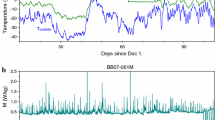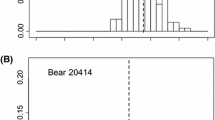Summary
Polar bears (Ursus maritimus) regulate their body temperatures both physiologically and behaviourally proportional to their level of activity while within the thermoneutral zone. Core temperatures (T c=36.9±0.5°C at rest) varied with the 4th power of walking speed for the two subadult (220 kg) bears tested, whereas subcutaneous temperatures (T sk=35.3±2.2°C at rest) were closely correlated withT c but also varied with wind speed (v a) and ambient temperature (T a). Radiative fur temperatures (T r) were closely correlated withT a and negligibly withT sk. Predictive equations for these temperature relationships were derived by regression analysis. Maximum rates of heat storage (S max) were above that predicted from the literature implying that the polar bear is an energetically costly walker. Radiative heat losses of a resting polar bear amount to between 36–67% of the metabolism and assuming a respiratory heat loss of 7–10%, convective heat losses (by difference) would thus range from 33–64%. When walking, the cooling of the fur surface by forced convection and the ‘pendulum’ effect of the moving legs of the bear lead to estimated convective heat losses on the order of 75% of the heat production while radiative losses are reduced to 13–22%. Increasing wind speeds enhance further this reciprocal effect.
Similar content being viewed by others
References
Bakken GS (1976) A heat transfer analysis of animals: unifying concepts and the application of metabolism chamber data to field ecology. J Theor Biol 60:337–384
Bakken GS, Gates DM (1976) Heat transfer analysis of animals: some implications for field ecology, physiology and evolution. In: Gates DM, Schmerl RB (eds) Perspectives of biophysical ecology. Ecological studies, vol 12. Springer, Berlin Heidelberg New York, pp 255–290
Barnes C, Davies CTM (1970) Body temperature and exercise. J Physiol (Lond) 210:159–160
Best RC, Ronald K, Øritsland NA (1981) Physiological indices of activity and metabolism in the polar bear. Comp Biochem Physiol [A] 69:177–185
Bligh J (1973) Temperature regulation in mammals and other vertebrates. North-Holland, London, pp 1–436
Burton AC (1935) The average temperature of the tissues of the body. J Nutr 9:261–280
Burton AC, Edholm OG (1969) Man in a cold environment. Hafner, London, pp 1–273
Chassin PS, Taylor CR, Heglund NC, Seeherman HJ (1976). Locomotion in lions: energetic cost and maximum aerobic capacity. Physiol Zool 49:1–10
Clark RP, Mulligan BJ, Pugh LGCE, Toy N (1974) Heat losses from the moving limbs in running: the ‘pendulum’ effect. J Physiol (Lond) 240:8–9
Colin J, Timbal J, Houdas Y, Boutelier C, Guieu JD (1971) Computation of mean body temperatures from rectal and skin temperatures. J Appl Physiol 31:484–489
Crawford EC (1962) Mechanical aspects of panting in dogs. J Appl Physiol 17:249–251
Daigo M, Sato Y, Otsuka M, Yoshimura T, Komyama S, Ogawa Y (1972) (Stereoroentgenographical studies on peripheral arteries of the anterior and posterior extremities of the bears.) Bull Nippon Vet Zootech Coll 21:32–40 (in Japanese)
Fedak MA, Pinshow B, Schmidt-Nielsen K (1974). Energy cost of bipedal running. Am J Physiol 227:1038–1044
Finch V (1976) An assessment of the energy budget of Boran cattle. J Therm Biol 1:143–148
Folk GE, Folk MA, Minor JJ (1972) Physiological condition of three species of bears in winter dens. In: Herrero S (ed) Bears: their biology and management, vol 23. Int Union Conserv Nature Publ, pp 107–124
Frisch J, Øritsland, Krog J (1974) Insulation of furst in water. Comp Biochem Physiol [A] 47:403–410
Hales JRS, Brown GD (1974) Net energetic and themoregulatory efficiency during panting in the sheep. Comp Biochem Physiol [A] 49:413–422
Hammel HT, Houpt TR, Anderson KL (1962) Thermal and metabolic measurements on a reindeer at rest and in exercise. US Air Force Arctic Aeromed Lab, Fort Wainwright, Alaska, Tech doc Rep AAL-TDR-61-54, pp 1–34
Hanson R de G (1974) Respiratory heat loss at increased core temperature. J Appl Physiol 37:103–107
Hardy JD, DuBois ED (1938) Basal metabolism, radiation, convection and evaporation at temperatures of 22°C–35°C. J Nutr 15:477–492
Henshaw RE, Underwood LS, Casey TM (1972) Peripheral thermoregulation: foot temperature in two arctic carnivores. Science 175:988–990
Hock RJ (1960) Seasonal variations in physiological functions of arctic ground squirrels and black bears. In: Lyman CP, Dawe AR (ed) Mammalian hibernation I, Harvard University Press, Cambridge, MA, pp 155–171
Hock JR (1968) Some physiological measurements of polar bears. Z Säugetierkd 33:57–62
Jackson DC, Hammel HT (1963) Hypothalamic “set” temperature decreased in exercising dog. Life Sci 8:554–563
Lentz CP, Hart JS (1960) The effect of wind on heat loss through the fur of newborn caribou. Can J Zool 38:679–687
Lønø O (1970) The polar bear (Ursus maritimus Phipps) in the Svalbard area. Nor Polarinst Skr 149:1–103
Maxwell RK, Thorkelson J (1975) The field energetics of winterdormant bear (Ursus americanus) in northeastern Minnesota. Final Report 1971–1975, North Central Forest Exp Stn, US Forest Service, Minnesota, pp 1–50
Minard D (1970) Body heat content. In: Hardy JD, Gagge AP, Stolwijk JAJ (eds) Behavioural temperature regulation. Thomas, IL, pp 345–357
Moen AN (1973) Wildlife ecology; an analytical approach. Freeman, San Francisco, CA, pp 1–458
Moen AN (1974) Radiant temperatures of hair surfaces. J Range Manage 27:401–403
Moen AN, Jacobsen FL (1974) Changes in radiant temperature of animal surfaces with wind and radiation. J Wildl Manage 38:366–368
Moen AN, Jacobsen NK (1975) Thermal exchange, physiology, and behaviour of white-tailed deer. In: Gates DM, Schmerl RB (eds) Perspectives of biophysical ecology. Springer, Berlin Heidelberg New York, pp 509–524
Nielsen B (1969) Thermoregulation in rest and exercise. Acta Physiol Scand (Suppl) 323:1–74
Nishi Y (1973) Direct evaluation of the convective heat transfer coefficient for various activities and environments. Arch Sci Physiol [A] 274:59–66
Øritsland NA (1969) Deep body temperatures of swimming and walking polar bear cubs. J Mammal 50:380–382
Øritsland NA (1970) Temperature regulation of the polar bear (Thalarctos maritimus). Comp Biochem Physiol 37:225–233
Øritsland NA, Lentfer J, Ronald K (1974) Radiative surface temperatures of the polar bear. J Mammal 55:459–461
Øritsland NA, Jonkel C, Ronald K (1976) A respiration chamber for exercising polar bears. Norw J Zool 24:65–67
Porter WP, Gates DM (1969) Thermodynamic equilibrium of animals with the environment. Ecol Monogr 39:227–244
Saltin B, Gagge AP, Stolwijk JAJ (1970) Body temperatures and sweating during thermal transients caused by exercise. J Appl Physiol 28:318–327
Schmidt-Nielsen K, Bretz WL, Taylor CR (1970) Panting in dogs: unidirectional air flow over evaporative surfaces. Science 169:1102–1104
Scholander PR, Walters V, Hock R, Irving L (1950a) Body insulation of some arctic and tropical mammals and birds. Biol Bull 99:225–236
Scholander PF, Hock R, Walters V, Johnston F, Irving L (1950b) Heat regulation in some arctic and tropical mammals and birds. Biol Bull 99:237–258
Scholander PF, Hock R, Walters V, Irving L (1950c) Adaptation to cold in arctic and tropical mammals and birds in relation to body temperature, insulation and basal metabolic rate. Biol Bull 99:259–271
Skutt HR, Bock FM, Haugstad P, Holter JB, Hayes HH, Silver H, (1973) Low power implantable transmitters for telemetry of heart rate and temperature from white-tailed deer. J Wildl Manage 37:413–417
Stahl WR (1967) Scaling of respiratory variables in mammals. J Appl Physiol 22:453–460
Taylor CR (1974) Exercise and thermoregulation. In: Robertshaw D (ed) Environmental physiology. Butterworth, London. pp 163–184
Taylor CR, Rowntree VJ (1973) Temperature regulation and heat balance in running cheetahs: a strategy for sprinters. Am J Physiol 224:848–851
Taylor CR, Schmidt-Nielsen K, Raab JL (1970) Scaling energetic cost of running to body weight of animals. Am J Physiol 219:1104–1107
Walker JEC, Wells RE, Merrill ES (1960) Heat and water exchange in the respiratory tract. Am J Med 30:259–267
Yoshimura M, Hori S, Yoshimura H (1972) Effect of a high-fat diet on thermal acclimation, with special reference to thyroid activity. Jpn J Physiol 22:517–531
Author information
Authors and Affiliations
Rights and permissions
About this article
Cite this article
Best, R.C. Thermoregulation in resting and active polar bears. J Comp Physiol B 146, 63–73 (1982). https://doi.org/10.1007/BF00688718
Accepted:
Issue Date:
DOI: https://doi.org/10.1007/BF00688718




